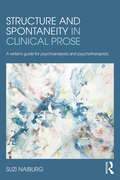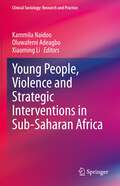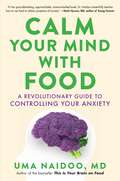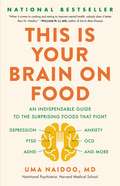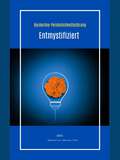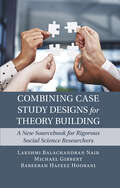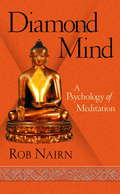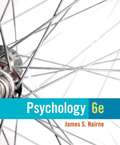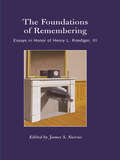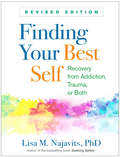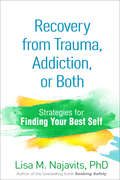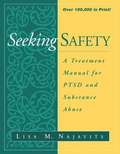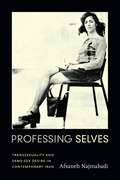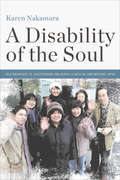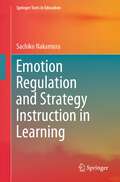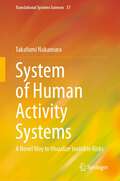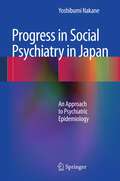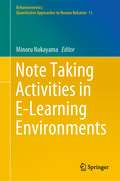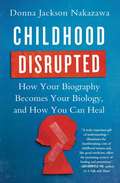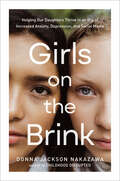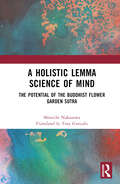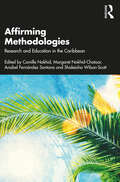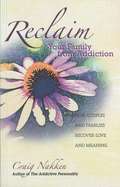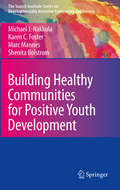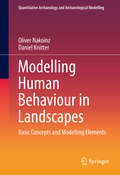- Table View
- List View
Structure and Spontaneity in Clinical Prose: A writer's guide for psychoanalysts and psychotherapists
by Suzi NaiburgStructure and Spontaneity in Clinical Prose will teach you to read gifted writers for inspiration and practical lessons in the craft of writing; apply the principles and techniques of the paradigmatic, narrative, lyric narrative, evocative, and enactive modes of clinical prose; and put what you learn immediately into practice in eighty-four writing exercises. Each of the five modes uses different means to construct worlds out of language. The paradigmatic abstracts ideas from experience to build concepts and theories. The narrative mode organizes experience through time, creating meaningful relationships between causes and effects. Lyric narratives present events unfolding in an uncertain present. The evocative mode works by invitation and suggestion, and the enactive mode creates an experience to be lived as well as thought. Structure and Spontaneity is fundamentally a book about reading and writing in new and different ways. It is an invaluable resource for new and experienced psychoanalysts and psychotherapists and for students, teachers, editors, and writers in the humanities and social sciences.
Young People, Violence and Strategic Interventions in Sub-Saharan Africa (Clinical Sociology: Research and Practice)
by Kammila Naidoo Oluwafemi Adeagbo Xiaoming LiThis edited volume offers a rich collection of up-to-date research and critical scholarship from various African institutions on incidents of youth violence, intervention and prevention in sub-Saharan Africa. It integrates thinking, evidence, responses, and debates relating to this topic, laying the basis for fresh insights and innovative strategies. The chapters capture a spectrum of pertinent issues such as economic hardship, lockdowns, sexual and reproductive health, pregnancy, online sexual harassment, xenophobic violence, and micro-aggressions in school contexts, and present guidelines on how countries might learn from successful interventions recently implemented. They explore young people’s access to familial and community resources, state-sponsored initiatives, peer counselling, youth-friendly services, and other relevant structures. Thus, among other things, this volume stimulates further debate on what is driving violence in different African contexts—specifically, how intersectional identities create vulnerabilities to violence—and influences ways of dealing with the issue. This interdisciplinary and cross-cutting volume serves as a vital resource for experts at universities, in international organisations, civil society groups and intergovernmental organisations who wish to both analyse and take action to address and prevent the type of violence that currently afflicts young people sub-Saharan Africa today.
Calm Your Mind with Food: A Revolutionary Guide to Controlling Your Anxiety
by Uma NaidooRelieve your anxiety through food with this "groundbreaking," full-body approach to mental health (Mark Hyman, MD), from bestselling author and nutritional psychiatrist Uma Naidoo, MD In this groundbreaking guide, Dr. Uma Naidoo presents cutting-edge research about the ways anxiety is rooted in the brain, gut, immune system, and metabolism. Drawing on the latest science on the connection between diet and anxiety, Dr. Naidoo shows us how to effectively use food and nutrition as essential tools for calming the mind. In Calm Your Mind with Food, you&’ll learn: How inflammation affects everything from anxiety and depression to Alzheimer&’s disease How the trillions of bacteria living in your gut are key to controlling anxiety The six pillars for calming the mind What to eat to balance leptin, a key link between the central nervous system and metabolic processes How to incorporate anxiety-busting foods into your diet, from the obscure (ashwagandha) to the ubiquitous (vitamin C) The best diets for managing symptoms of anxiety and depression Along with guidelines for creating your own personal anti-anxiety meal plan and dozens of supernutrient-forward, delicious recipes, Calm Your Mind with Food will help you boost your immunity, reduce anxiety, and enhance your overall mental well-being.
This Is Your Brain on Food: An Indispensable Guide to the Surprising Foods that Fight Depression, Anxiety, PTSD, OCD, ADHD, and More
by Uma NaidooEat for your mental health and learn the fascinating science behind nutrition with this "must-read" guide from an expert psychiatrist (Amy Myers, MD).Did you know that blueberries can help you cope with the aftereffects of trauma? That salami can cause depression, or that boosting Vitamin D intake can help treat anxiety?When it comes to diet, most people's concerns involve weight loss, fitness, cardiac health, and longevity. But what we eat affects more than our bodies; it also affects our brains. And recent studies have shown that diet can have a profound impact on mental health conditions ranging from ADHD to depression, anxiety, sleep disorders, OCD, dementia and beyond.A triple threat in the food space, Dr. Uma Naidoo is a board-certified psychiatrist, nutrition specialist, and professionally trained chef. In This Is Your Brain on Food, she draws on cutting-edge research to explain the many ways in which food contributes to our mental health, and shows how a sound diet can help treat and prevent a wide range of psychological and cognitive health issues.Packed with fascinating science, actionable nutritional recommendations, and delicious, brain-healthy recipes, This Is Your Brain on Food is the go-to guide to optimizing your mental health with food.
Borderline-Persönlichkeitsstörung Entmystifiziert
by Abhimanu S NairEinsamkeit ist eine Situation, die wir alle in verschiedenen Phasen unseres Lebens erleiden, aber niemand fürchtet das Gefühl des Alleinseins so sehr wie eine Person mit einer Borderline-Persönlichkeitsstörung. Eine psychische Störung, die dazu führt, dass das Opfer intensive Momente der Liebe hat, in denen es ihren geliebten Menschen als perfekte Individuen sieht, nur um plötzlich seine Meinung über dieselbe Person zu ändern. Im Wechsel zwischen diesem Muster der Idealisierung ihrer Lieben und der Abwertung von ihnen zeigt eine BPS ein inkohärentes Verhalten, das es schwierig macht, ihr Freund für zu lange Zeit zu sein. Sie reagieren auf die Möglichkeit, verlassen zu werden, indem sie sich selbst bedrohen und tatsächlich verletzen, sich in riskanten sexuellen Aktivitäten, Drogenmissbrauch und exzessivem Einkaufen ergehen. Wenn Sie mit ihnen zusammen sind, werden Sie auch Situationen erlebt haben, in denen sie Selbstmord erwägen und versuchen. Jemanden zu lieben, der eine Borderline-Persönlichkeitsstörung hat, ist keine leichte Aufgabe. Sie werden dich emotional erschöpft, unsicher und paranoid zurücklassen, weshalb du Schritte unternehmen musst, um dich selbst zu schützen, damit du nicht auch rückfällig wirst und selbst zum Patienten mit psychischen Problemen wirst.
Combining Case Study Designs for Theory Building: A New Sourcebook for Rigorous Social Science Researchers
by Lakshmi Balachandran Nair Michael Gibbert Bareerah Hafeez HooraniCase study research is a versatile approach that allows for different data sources to be combined, with its main purpose being theory development. This book goes a step further by combining different case study research designs, informed by the authors' extensive teaching and research experience. It provides an accessible introduction to case study research, familiarizes readers with different archetypical and sequenced designs, and describes these designs and their components using both real and fictional examples. It provides thought-provoking exercises, and in doing so, prepares the reader to design their own case study in a way that suits the research objective. Written for an academic audience, this book is useful for students, their supervisors and professors, and ultimately any researcher who intends to use, or is already using, the case study approach.
Diamond Mind
by Rob NairnBuddhism teaches that the mind is the source of 100 percent of all unhappiness: anxiety, agitation, desire, anger, grief. Through understanding how our mind works, it is possible to tame it--and to discover that happiness, wisdom, compassion, and clarity are actually inherent qualities in all of us. Much has been written of this subject, but Rob Nairn's book is the first to express the principles of Buddhist psychology in a way that is so easy to understand and enjoyable to read--while remaining remarkably accurate and complete. Each chapter includes exercises that bring the truth of the teaching home.
Psychology
by James NairneStraightforward and written in a friendly style, James S. Nairne's PSYCHOLOGY, Sixth Edition, uses a proven problem-solving approach to help you discover how to apply psychology to your everyday life. Dr. Nairne introduces topics by focusing on the "why" behind psychological processes before introducing what they are and how they work. You'll learn that our brains are filled with psychological "tools" that control everything from emotion to memory, and that each helps us adapt and solve important everyday problems. Nairne describes these tools, shows you how they're used, and focuses on specific situations in which they are applied. Emphasizing critical thinking and active learning, PSYCHOLOGY, Sixth Edition, provides current, comprehensive, and practical coverage that you can immediately put to good use.
The Foundations of Remembering: Essays in Honor of Henry L. Roediger, III (Psychology Press Festschrift Series)
by James S. NairneThe Foundations of Remembering presents a collection of essays written by top memory scholars in honor of Henry L. Roediger III. The chapters were originally delivered as part of the "Roddyfest" conference held in March 2005 to celebrate Purdue University's awarding of an honorary doctor of letters to Roediger in recognition of his many contributions to the field of psychology. Authors were given a simple charge: choose your own topic, but place your work in historical context. Roediger is fascinated by the intellectual lineage of ideas, so addressing historical "foundations" seemed a fitting tribute. The Chapters contained in this volume help to establish the foundations of remembering, circa the first decade of the 21st century, as perceived by some of the leading memory researchers in the world. Not surprisingly, each of the chapters touches on Roediger's research as well, largely because his work has helped to define and clarify many topics of interest to the memory field. The Foundations of Remembering is intended for a wide audience: students, scholars, and anyone interested in exploring the historical and conceptual roots of modern memory theory.
Finding Your Best Self, Revised Edition: Recovery from Addiction, Trauma, or Both
by Lisa M. NajavitsAddiction and trauma are two of the most common and difficult issues that people face. In this motivating book, leading expert Lisa Najavits explains the link between addiction and trauma and presents science-based self-help strategies that you can use no matter where you are in your recovery. Every chapter features inspiring words from people who have "been there," plus carefully designed reflection questions, exercises, and other practical tools. Learn how you can: *Build coping skills so that the future is better than the past. *Keep yourself safe and find support. *Set your own goals and make a plan to achieve them at your own pace. *Choose compassion over self-blame and shame. *Move toward your best self--the person you want to be. If you are a family member or friend seeking to support a loved one--or a helping professional--this book is also for you. Now in a convenient large-size format, the revised edition features added materials for professional and peer counselors. First edition title: Recovery from Trauma, Addiction, or Both. Mental health professionals, see also the author's Seeking Safety: A Treatment Manual for PTSD and Substance Abuse, which presents an evidence-based treatment approach developed specifically for PTSD and substance abuse.
Recovery from Trauma, Addiction, or Both: Strategies for Finding Your Best Self
by Lisa M. NajavitsTrauma and addiction are two of the most common and difficult issues that people face--but it truly is possible to heal. In this motivating book, leading expert Lisa Najavits explains the link between trauma and addiction and presents science-based self-help strategies that you can use no matter where you are in your recovery. Every chapter features inspiring words from people who have "been there," plus carefully designed reflection questions, exercises, and other practical tools. Learn how you can: *Build coping skills so that the future is better than the past. *Keep yourself safe and find support. *Set your own goals and make a plan to achieve them at your own pace. *Choose compassion over self-blame and shame. *Move toward your best self--the person you want to be. Mental health professionals, see also the author's Seeking Safety: A Treatment Manual for PTSD and Substance Abuse, which presents an evidence-based treatment approach developed specifically for PTSD and substance abuse.
Seeking Safety: A Treatment Manual for PTSD and Substance Abuse
by Lisa M. NajavitsThis much-needed manual presents the first empirically studied, integrative treatment approach developed specifically for PTSD and substance abuse. For persons with this prevalent and difficult-to-treat dual diagnosis, the most urgent clinical need is to establish safety-to work toward discontinuing substance use, letting go of dangerous relationships, and gaining control over such extreme symptoms as dissociation and self-harm. The manual is divided into 25 topics, each of which forms the basis for one or more sessions. Covering a range of cognitive, behavioral, and interpersonal issues, topics include highly practical tools and techniques to engage patients in treatment; teach "safe coping skills" that apply to both disorders; and restore ideals that have been lost, including respect, care, protection, and healing. Structured yet flexible, sessions can be conducted in any order and in a range of settings. The volume is designed for maximum ease of use with a large-size format and helpful reproducible handouts and forms.
Professing Selves: Transsexuality and Same-Sex Desire in Contemporary Iran
by Afsaneh NajmabadiSince the mid-1980s, the Islamic Republic of Iran has permitted, and partially subsidized, sex reassignment surgery. In Professing Selves, Afsaneh Najmabadi explores the meaning of transsexuality in contemporary Iran. Combining historical and ethnographic research, she describes how, in the postrevolutionary era, the domains of law, psychology and psychiatry, Islamic jurisprudence, and biomedicine became invested in distinguishing between the acceptable "true" transsexual and other categories of identification, notably the "true" homosexual, an unacceptable category of existence in Iran. Najmabadi argues that this collaboration among medical authorities, specialized clerics, and state officials--which made transsexuality a legally tolerated, if not exactly celebrated, category of being--grew out of Iran's particular experience of Islamicized modernity. Paradoxically, state regulation has produced new spaces for non-normative living in Iran, since determining who is genuinely "trans" depends largely on the stories that people choose to tell, on the selves that they profess.
A Disability of the Soul
by Karen NakamuraBethel House, located in a small fishing village in northern Japan, was founded in 1984 as an intentional community for people with schizophrenia and other psychiatric disorders. Using a unique, community approach to psychosocial recovery, Bethel House focuses as much on social integration as on therapeutic work. As a centerpiece of this approach, Bethel House started its own businesses in order to create employment and socialization opportunities for its residents and to change public attitudes toward the mentally ill, but also quite unintentionally provided a significant boost to the distressed local economy. Through its work programs, communal living, and close relationship between hospital and town, Bethel has been remarkably successful in carefully reintegrating its members into Japanese society. It has become known as a model alternative to long-term institutionalization. In A Disability of the Soul, Karen Nakamura explores how the members of this unique community struggle with their lives, their illnesses, and the meaning of community. Told through engaging historical narrative, insightful ethnographic vignettes, and compelling life stories, her account of Bethel House depicts its achievements and setbacks, its promises and limitations. The book is accompanied by a DVD containing two fascinating documentaries about Bethel made by the author-Bethel: Community and Schizophrenia in Northern Japan and A Japanese Funeral (winner of the Society for Visual Anthropology Short Film Award and the Society for East Asian Anthropology David Plath Media Award). A Disability of the Soul is a sensitive and multidimensional portrait of what it means to live with mental illness in contemporary Japan.
Emotion Regulation and Strategy Instruction in Learning (Springer Texts in Education)
by Sachiko NakamuraThis textbook is written for teachers, practitioners, and researchers, who are interested in developing their knowledge about emotions and learning about ways of helping their learners to cultivate positive and cope with negative emotions. The book covers the topics of emotions, emotion regulation, strategies, and instruction. Each topic is discussed in the subsequent chapters, beginning with a concise summary of theories and research in the fields of psychology, education, and language learning. This is followed by its practical applications in the classroom, with suggestions and ideas based on research as well as reports from teachers in a wide range of contexts. Teachers’ vignettes give readers an opportunity to compare their experiences with others. A practical guide with detailed steps for implementing strategy instruction in emotion regulation is provided at the end.
System of Human Activity Systems: A Novel Way to Visualize Invisible Risks (Translational Systems Sciences #37)
by Takafumi NakamuraThis book has unique features that set it apart from conventional books on the prevention of system failures in that it provides a method that views human activities from a meta-methodological perspective based upon an inter-disciplinary understanding of human activities. With these characteristics, the book also proposes a common methodological basis to apply to various problems surrounding society today such as an aging social infrastructure; the safety of food, medicine, and public transportation; and the creation of sustainable electricity and cybersecurity. Furthermore, since the failure of human activities is expressed in a three-dimensional space and the topological metrics are implemented, the failure trajectories can be quantitatively monitored in time series to take effective preventive measures. Considering the implementation of the topological metrics, the causes of each failure are classified into two dimensions of the degree of coupling between system elements and the interaction between the target system and the external environment. Owing to the nature of the introduction of topological metrics, all individual and diverse systems can share general topological metrics. Consequently, understanding various failures over cross-industries is possible with the use of common meta-systemic language and mutual learning between different industries, and the solution of social problems can be effectively achieved. A system of system failures (SOSF) proposed and confirmed the effectiveness of this meta-methodology for information and communication technologies (ICT) systems and the SOSF is extended to human activity systems (SOHAS: system of human activity systems) as a whole. Therefore, the SOHAS becomes an academic foundation for theoretical research on meta-methodology, and it has an impact on practitioners to prevent system failures by accumulating knowledge of failures and learning from other industries.
Progress in Social Psychiatry in Japan
by Yoshibumi NakaneSocial psychiatry is a multidisciplinary field analyzing mechanisms of mental health issues comprehensively to contribute to society using the findings. Those findings include biological, psychological, and social aspects and they are based on psychiatry and connected with a wide variety of academic fields, including psychology, sociology, law, economics, and religious studies. Epidemiological research in psychiatry is a field of study in patients with psychiatric disorder attempting to investigate causes, to develop clinical applications of the results, and to determine applications to health services plans for individuals and/or communities. They are both foundation for understanding biopsychosocial view in psychiatry but not many comprehensive volumes covering the topic were not available until now. This book is thus a unique, comprehensive reference with evidence-based approach to provide concise summary of researches for such as schizophrenia, affective disorders, psychiatric disorders in the general practice setting, and disaster psychiatry, especially for the case of atomic bomb diseases. The studies were mostly carried out in the region of Nagasaki, the prefecture experienced a nuclear attack at the time of World War . Psychiatric findings in mental health problems among atomic bomb survivors and sufferers in Nagasaki has been established and Nagasaki is the only area that fulfills the conditions of the subject of the study of psychiatric epidemiology and social psychiatry which is going to be described in this book. This book provides a valuable resource not only for physicians and researchers in the field of psychiatry and mental health but for people who work for mental health welfare department.
Note Taking Activities in E-Learning Environments (Behaviormetrics: Quantitative Approaches to Human Behavior #11)
by Minoru NakayamaThe main focus of this book is presenting practical procedures for improving learning effectiveness using note taking activities during e-learning courses. Although presentation of e-learning activities recently has been spreading to various education sectors, some practical problems have been discussed such as evaluation of learning performance and encouragement of students. The authors introduce note taking activity as a conventional learning tool in order to promote individual learning activity and learning efficacy. The effectiveness of note taking has been measured in practical teaching in a Japanese university using techniques of learning analytics, and the results are shown here. The relationships between note taking activity and students’ characteristics, the possibility of predicting the final learning performance using metrics of students’ note taking, and the effectiveness for individual emotional learning factors are evaluated. Some differences between blended learning and fully online learning courses are also discussed. The authors provide novel analytical procedures and ideas to manage e-learning courses. In particular, the assessment of note taking activity may help to track individual learning progress and to encourage learning motivation.
Childhood Disrupted: How Your Biography Becomes Your Biology, and How You Can Heal
by Donna Jackson NakazawaA &“courageous, compassionate, and rigorous every-person&’s guide&” (Christina Bethell, PhD, Johns Hopkins Bloomberg School of Public Health) that shows the link between Adverse Childhood Experiences (ACEs) and diseases, and how to cope and heal from these emotional traumas.Your biography becomes your biology. The emotional trauma we suffer as children not only shapes our emotional lives as adults, but it also affects our physical health, longevity, and overall well-being. Scientists now know on a bio-chemical level exactly how parents&’ chronic fights, divorce, death in the family, being bullied or hazed, and growing up with a hypercritical, alcoholic, or mentally ill parent can leave permanent, physical &“fingerprints&” on our brains.When children encounter sudden or chronic adversity, stress hormones cause powerful changes in the body, altering the body&’s chemistry. The developing immune system and brain react to this chemical barrage by permanently resetting children&’s stress response to &“high,&” which in turn can have a devastating impact on their mental and physical health as they grow up.Donna Jackson Nakazawa shares stories from people who have recognized and overcome their adverse experiences, shows why some children are more immune to stress than others, and explains why women are at particular risk. &“Groundbreaking&” (Tara Brach, PhD, author of Radical Acceptance) in its research, inspiring in its clarity, Childhood Disrupted explains how you can reset your biology—and help your loved ones find ways to heal. &“A truly important gift of understanding—illuminates the heartbreaking costs of childhood trauma and like good medicine offers the promising science of healing and prevention&” (Jack Kornfield, author of A Path With Heart).
Girls on the Brink: Helping Our Daughters Thrive in an Era of Increased Anxiety, Depression, and Social Media
by Donna Jackson Nakazawa15 revelatory strategies for raising emotionally healthy girls, based on cutting-edge science that explains the modern pressures that make it so difficult for adolescent girls to thrive&“This is a brave and important book; the challenging stories—both personal and scientific—will make you think, and, hopefully, act.&”—Bruce D. Perry, MD, PhD, New York Times bestselling co-author of What Happened to You?Anyone caring for girls today knows that our daughters, students, and girls next door are more anxious and more prone to depression and self-harming than ever before. The question that no one has yet been able to credibly answer is Why? Now we have answers. As award-winning writer Donna Jackson Nakazawa deftly explains in Girls on the Brink, new findings reveal that the crisis facing today&’s girls is a biologically rooted phenomenon: the earlier onset of puberty mixes badly with the unchecked bloom of social media and cultural misogyny. When this toxic clash occurs during the critical neurodevelopmental window of adolescence, it can alter the female stress-immune response in ways that derail healthy emotional development.But our new understanding of the biology of modern girlhood yields good news, too. Though puberty is a particularly critical and vulnerable period, it is also a time during which the female adolescent brain is highly flexible and responsive to certain kinds of support and scaffolding. Indeed, we know now that a girl&’s innate sensitivity to her environment can, with the right conditions, become her superpower. Jackson Nakazawa details the common denominators of such support, shedding new light on the keys to preventing mental health concerns in girls as well as helping those who are already struggling. Drawing on insights from both the latest science and interviews with girls about their adolescent experiences, the author carefully guides adults through fifteen &“antidote&” strategies to help any teenage girl thrive in the face of stress, including how to nurture the parent-child connection through the rollercoaster of adolescence, core ingredients to building a sense of safety and security for your teenage girl at home, and how to foster the foundations of long-term resilience in our girls so they&’re ready to face the world.Neuroprotective and healing, the strategies in Girls on the Brink amount to a new playbook for how we—parents, families, and the human tribe—can secure a healthy emotional inner life for all of our girls.
A Holistic Lemma Science of Mind: The Potential of the Buddhist Flower Garden Sutra
by Shinichi NakazawaNakazawa connects Buddhist philosophy with modern sciences such as psychology, quantum theory, and mathematics, as well as linguistics and the arts to present a perspective on understanding the mind in a world built on interconnection and networks of relations. While Lemma Science is a new and modern study of humans, its provenance is deeply rooted in the Eastern thought tradition. The ancient Greeks identified two modes of human intelligence: the logos and lemma intellects. Etymologically, logos signifies to "arrange and organize what has been gathered in front of one's self." To practice logos-based thinking, one must rely on language. Thus, humans organize and understand the objects in the universe according to linguistic syntax. In contrast, lemma etymologically signifies the intellectual capacity to "grasp the whole at once." Instead of arranging objects along a time axis, as language does, the lemma intellect perceives the world in an intuitive, non-linear and non-causal manner, comprehending the whole in an instant. This book embarks on a venture to establish a new science based upon the lemma intellect. Using non-logos-based materials, rigorously following lemma-based methods, and transgressing the boundaries of academic fields, Nakazawa seeks to construct this new science as a fluid, dynamic entity. This book will be of great interest to researchers across the fields of Japanese studies, Buddhist studies, psychology and linguistics.
Affirming Methodologies: Research and Education in the Caribbean
by Camille NakhidAffirming Methodologies: Research and Education in the Caribbean centres local and indigenous ways of knowing in research and education praxis in the Caribbean. The research methodologies and pedagogies are presented in this book within an Affirming Methodologies framework. They bring forward localized epistemologies whereby Caribbean ways of being and knowing are affirmed, and the expected western hierarchies between researcher and researched are removed. The chapters present approaches to knowledge construction and knowledge sharing based on practices, lived experiences, traditions, language patterns, and rituals of Caribbean communities. The importance of an Affirming Methodologies approach is demonstrated, and the characteristics of culturally affirming research methodologies and pedagogies in diverse environments including Cuba, Trinidad and Tobago, Jamaica and the Caribbean diaspora in Aotearoa New Zealand and Canada are explored and presented. Grounded on an understanding of the authors’ Caribbean positionality, ontological distinctions within the Caribbean research context are considered. This book moves forward from a decolonizing methodology approach, and, as such, the chapters are written, not in opposition to, or tested against Eurocentric approaches to research, but deeply rooted in a Caribbean ethos. This book will engage researchers (both qualitative and quantitative), postgraduate students, academics, practitioners, policymakers, community workers, and lay persons who seek to employ culturally relevant local and indigenous research approaches in their work. Each chapter offers practical suggestions on the 'how' of research practice, making them accessible, relevant, and flexible for novice and seasoned researchers alike.
Reclaim Your Family From Addiction: How Couples and Families Recover Love and Meaning
by Craig NakkenWith histories, personal stories, and the latest research, this book helps readers chart their way out of addiction and back to the fullness of family by using principles that restore the "we" of lasting, loving relationships.What happens to the "we" of a family when one member opts for the blind and single-minded "me" of addiction? In an instructive, reassuring way, Craig Nakken explains just how families and couples who have spent years building a life together can lose their cohesive identity and meaning in the wake of addiction. The perfect starting point in the healing process, this book Reclaim Your Family From Addiction-also reminds us that recovery is possible--for individuals, couples, and whole families--if only we know what to do. With histories, personal stories, and the latest research, the book helps readers chart their own way out of the hell of addiction and back to the fullness of family by using principles that restore the "we" of lasting, loving relationships. Craig Nakken, M.S.W., author of The Addictive Personality and Men's Issues in Recovery, lectures, trains, and specializes as a family therapist in the treatment of addiction. He lives in Minneapolis, Minnesota.
Building Healthy Communities for Positive Youth Development (The Search Institute Series on Developmentally Attentive Community and Society #7)
by Michael J. Nakkula Shenita Bolstrom Marc Mannes Karen C. FosterThe Healthy Communities Healthy Youth (HC HY) project has provided grassroots support for the creation of robust, welcoming environments not only for children and adolescents at risk but for all youth. Building Healthy Communities for Positive Youth Development explains the Developmental Assets framework in depth and demonstrates how eight local initiatives across the country have adapted and implemented it to fit the unique cultures and resources of their neighborhoods and the needs and strengths of their young people. Stakeholders collaborating in the process include parents, educators, politicians, service providers, law enforcement, volunteers, and?as active participants instead of merely recipients of services?youth themselves. In this visionary book, the authors provide readers with a flexible, living blueprint for promoting the well-being of children and teenagers. Areas of coverage include: Core themes of the eight HC HY initiatives. The use of an asset-based common language among participants. Building common ground among the various sectors involved in the initiatives. The varied roles of young people within the initiatives. Research design and methodology; data collection and interpretation. Funding issues and challenges. The mission outlined in Building Healthy Communities for Positive Youth Development fits the interests of a wide range of professionals, including developmental psychologists; child, youth, and family service professionals; clinical child and school psychologists; and allied education and mental health practitioners working with children and adolescents.
Modelling Human Behaviour in Landscapes
by Oliver Nakoinz Daniel KnitterThis volume is designed as a 12-lecture textbook, which can serve as a course companion, self teaching guide and handbook for basic concepts. Each lecture comprises 20 pages, in which the methods are introduced, examples shown and the code is given. All examples are computed with open source software, mainly R, and with archaeological data available from the book's website. The book does not describe elaborated high-end models but rather very basic modelling concepts that serve as components in more complex models. The book enables the reader to construct such models by themselves and be sensitive for certain problems. In addition it gives hints for the interpretation of the results. Students are usually quick to apply fancy methods yet fail in the proper interpretation due to a lack of understanding of the underlying principles. This problem is addressed by the proposed book through three concepts: 1. Command line software forces the students to first learn some details before they are able to produce results on their own. 2. The book is focused on principles and methods. When the students understand a few basic principles, they have far better access to a wide range of related methods. 3. Examples of poor analysis highlight common pitfalls. The volume attempts to be an applied, minimalistic and efficient textbook and is based upon several successful courses.
